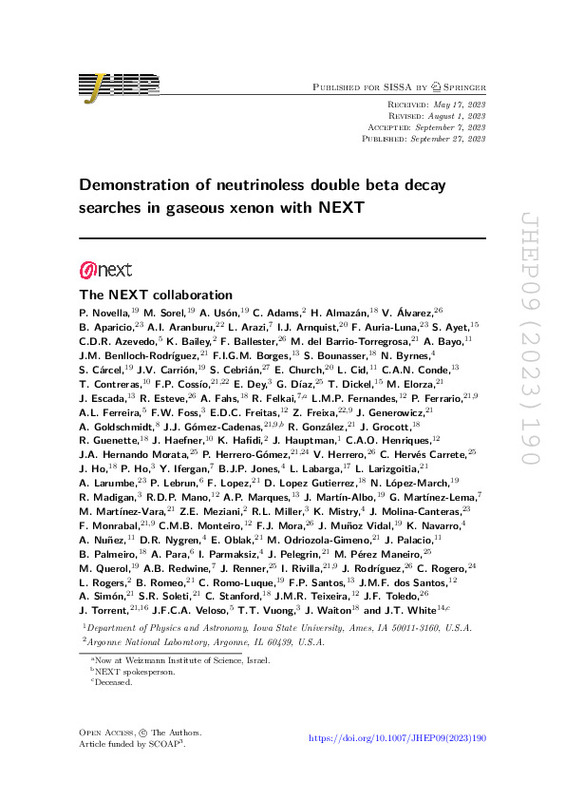Novella, P.; Sorel, M.; Usón, A.; Adams, C.; Almazán, H.; Álvarez-Puerta, V.; Aparicio, B.... (2023). Demonstration of neutrinoless double beta decay searches in gaseous xenon with NEXT. Journal of High Energy Physics (Online). 2023(9):1-28. https://doi.org/10.1007/JHEP09(2023)190
Por favor, use este identificador para citar o enlazar este ítem: http://hdl.handle.net/10251/202345
|
Título:
|
Demonstration of neutrinoless double beta decay searches in gaseous xenon with NEXT
|
|
Autor:
|
Novella, P.
Sorel, M.
Usón, A.
Adams, C.
Almazán, H.

 Álvarez-Puerta, Vicente
Aparicio, B.
Aranburu, A. I.
Arazi, L.
Arnquist, I.J.
Auria-Luna, F
Ayet, S.
C.D.R. Azevedo
Bailey, K.
Álvarez-Puerta, Vicente
Aparicio, B.
Aranburu, A. I.
Arazi, L.
Arnquist, I.J.
Auria-Luna, F
Ayet, S.
C.D.R. Azevedo
Bailey, K.

 Ballester Merelo, Francisco José
Ballester Merelo, Francisco José

 Esteve Bosch, Raul
Esteve Bosch, Raul

 Herrero Bosch, Vicente
Herrero Bosch, Vicente

 Mora Mas, Francisco José
Rodriguez-Samaniego, Javier
Mora Mas, Francisco José
Rodriguez-Samaniego, Javier

 Toledo Alarcón, José Francisco
Toledo Alarcón, José Francisco
|
|
Entidad UPV:
|
Universitat Politècnica de València. Escuela Politécnica Superior de Gandia - Escola Politècnica Superior de Gandia
Universitat Politècnica de València. Escuela Técnica Superior de Ingenieros de Telecomunicación - Escola Tècnica Superior d'Enginyers de Telecomunicació
Universitat Politècnica de València. Escuela Técnica Superior de Ingenieros Industriales - Escola Tècnica Superior d'Enginyers Industrials
|
|
Fecha difusión:
|
|
|
Resumen:
|
[EN] The NEXT experiment aims at the sensitive search of the neutrinoless double beta decay in Xe-136, using high-pressure gas electroluminescent time projection chambers. The NEXT-White detector is the first radiopure ...[+]
[EN] The NEXT experiment aims at the sensitive search of the neutrinoless double beta decay in Xe-136, using high-pressure gas electroluminescent time projection chambers. The NEXT-White detector is the first radiopure demonstrator of this technology, operated in the Laboratorio Subterr & aacute;neo de Canfranc. Achieving an energy resolution of 1% FWHM at 2.6 MeV and further background rejection by means of the topology of the reconstructed tracks, NEXT-White has been exploited beyond its original goals in order to perform a neu-trinoless double beta decay search. The analysis considers the combination of 271.6 days of Xe-136-enriched data and 208.9 days of 136Xe-depleted data. A detailed background mod-eling and measurement has been developed, ensuring the time stability of the radiogenic and cosmogenic contributions across both data samples. Limits to the neutrinoless mode are obtained in two alternative analyses: a background-model-dependent approach and a novel direct background-subtraction technique, offering results with small dependence on the background model assumptions. With a fiducial mass of only 3.50 +/- 0.01 kg of Xe-136-enriched xenon, 90% C.L. lower limits to the neutrinoless double beta decay are found in the T-1/2(0 nu) > 5.5x10(23) -1.3x10(24) yr range, depending on the method. The presented techniques stand as a pro of-of-concept for the searches to be implemented with larger NEXT detectors.
[-]
|
|
Palabras clave:
|
Dark Matter and Double Beta Decay (experiments)
,
Rare Decay
|
|
Derechos de uso:
|
Reconocimiento (by)
|
|
Fuente:
|
Journal of High Energy Physics (Online). (eissn:
1029-8479
)
|
|
DOI:
|
10.1007/JHEP09(2023)190
|
|
Editorial:
|
Springer-Verlag
|
|
Versión del editor:
|
http://doi.org/10.1007/JHEP09(2023)190
|
|
Código del Proyecto:
|
info:eu-repo/grantAgreement/EC/H2020/951281/EU
...[+]
info:eu-repo/grantAgreement/EC/H2020/951281/EU
info:eu-repo/grantAgreement/EC/H2020/957202/EU
info:eu-repo/grantAgreement/NSF//NSF CHE 2004111/
info:eu-repo/grantAgreement/DOE//DE-AC02-06CH11357/
info:eu-repo/grantAgreement/DOE//DE-AC02-07CH11359/
info:eu-repo/grantAgreement/DOE//DE-FG02-13ER42020/
info:eu-repo/grantAgreement/DOE//DE-SC0019054/
info:eu-repo/grantAgreement/DOE//DE-SC0019223/
info:eu-repo/grantAgreement/FCT//UID%2FFIS%2F04559%2F2020/
info:eu-repo/grantAgreement/GVA//PROMETEO%2F2021%2F087/
info:eu-repo/grantAgreement/GVA//CIDEGENT%2F2019%2F049/
info:eu-repo/grantAgreement/ISF//1223%2F21/
info:eu-repo/grantAgreement/MINECO//CEX2018-000867-S/
info:eu-repo/grantAgreement/Fundació Bancària Caixa d'Estalvis i Pensions de Barcelona//LCF%2FBQ%2FPI22%2F11910019/
info:eu-repo/grantAgreement/Fundació Bancària Caixa d'Estalvis i Pensions de Barcelona//100010434/
info:eu-repo/grantAgreement/AEI/Programa Estatal para Impulsar la Investigación Científico-Técnica y su Transferencia/PID2021-125475NB-C52/Explotación científica del detector NEXT-100 y R&D para el detector NEXT-HD/
info:eu-repo/grantAgreement/Welch Foundation//Y-2031-20200401/
info:eu-repo/grantAgreement/PAZY//310%2F22/
info:eu-repo/grantAgreement/PAZY//315%2F19/
info:eu-repo/grantAgreement/PAZY//465%2F19/
[-]
|
|
Agradecimientos:
|
The NEXT Collaboration acknowledges support from the following agencies and institutions: the European Research Council (ERC) under Grant Agreement No. 951281-BOLD; the European Union's Framework Programme for Research and ...[+]
The NEXT Collaboration acknowledges support from the following agencies and institutions: the European Research Council (ERC) under Grant Agreement No. 951281-BOLD; the European Union's Framework Programme for Research and Innovation Horizon 2020 (2014-2020) under Grant Agreement No. 957202-HIDDEN; the MCIN/AEI of Spain and ERDF A way of making Europe under grants PID2021-125475NB and the Severo Ochoa Program grant CEX2018-000867-S; the Generalitat Valenciana of Spain under grants PROMETEO/2021/087 and CIDEGENT/2019/049; the Department of Education of the Basque Government of Spain under the predoctoral training program non-doctoral research personnel; the Spanish la Caixa Foundation (ID 100010434) under fellowship code LCF/BQ/PI22/11910019; the Portuguese FCT under project UID/FIS/04559/2020 to fund the activities of LIBPhys-UC; the Israel Science Foundation (ISF) under grant 1223/21; the Pazy Foundation (Israel) under grants 310/22, 315/19 and 465; the US Department of Energy under contracts number DE-AC02-06CH11357 (Argonne National Laboratory), DE-AC02-07CH11359 (Fermi National Accelerator Laboratory), DE-FG02-13ER42020 (Texas A&M), DE-SC0019054 (Texas Arlington) and DE-SC0019223 (Texas Arlington); the US National Science Foundation under award number NSF CHE 2004111; the Robert A Welch Foundation under award number Y-2031-20200401. Finally, we are grateful to the Laboratorio Subterraneo de Canfranc for hosting and supporting the NEXT experiment.
[-]
|
|
Tipo:
|
Artículo
|









